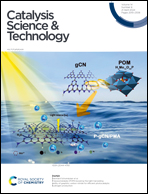Dispersing agglomerated Zn4In2S7 on g-C3N4 nanosheets to form a 2D/2D S-scheme heterojunction for highly selective photocatalytic cleavage of lignin models†
Abstract
Lignin can be transformed into aromatic feedstock chemicals through photocatalysis, serving as an alternative to fossil resources, thereby meeting the growing demand for alternative energy resources. Herein, we introduce a unique 2D/2D S-scheme heterojunction photocatalyst, formed by uniformly dispersing agglomerated Zn4In2S7 on g-C3N4 nanosheets, designed to effectively cleave the Cβ–O bond in lignin under mild conditions. The formation of the S-scheme heterojunction notably separates and retains the strong photogenerated electrons and holes of the two photocatalysts, exhibiting excellent redox capabilities. Simultaneously, the two-step reaction mechanism of photocatalytic depolymerization of lignin was postulated to be oxidation followed by reduction through detailed mechanistic studies. Finally, a 99% conversion rate was achieved for the lignin model compound, with phenol and acetophenone being produced in yields of 87% and 86%, respectively, and maintaining strong depolymerization performance over four experimental cycles. This groundbreaking research offers a new idea for the design of photocatalysts to depolymerize lignin.



 Please wait while we load your content...
Please wait while we load your content...